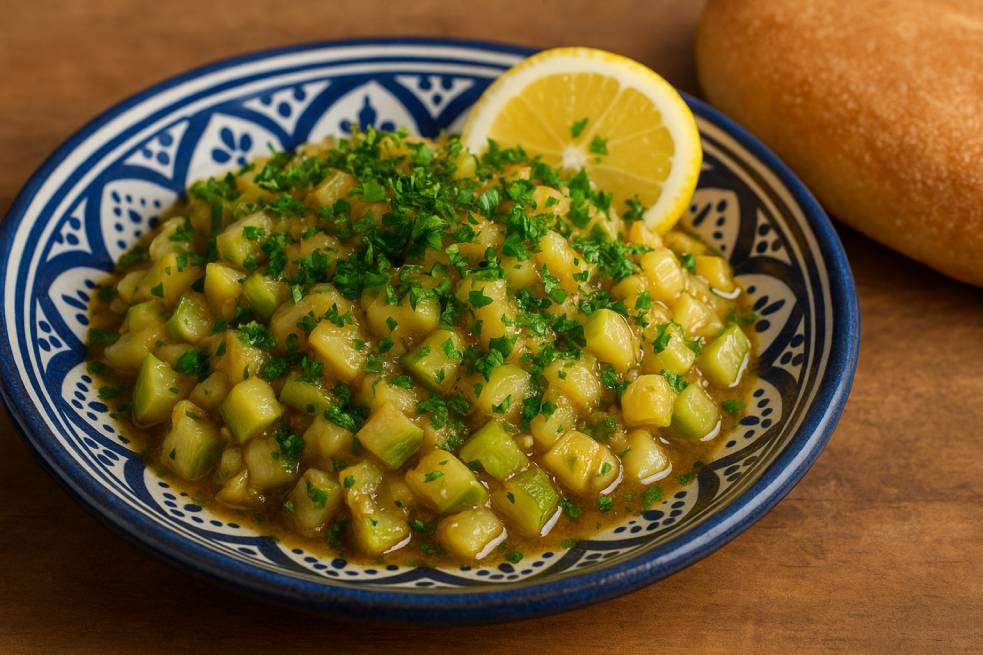Table of Contents
🥒 What Is Moroccan Zucchini Salad?
The Moroccan zucchini salad is a gently simmered dish where zucchini melts into a flavorful blend of olive oil, herbs, and warming spices. It reflects the warmth and depth of flavors that define everyday cooking in North African cuisine. Unlike raw Western-style zucchini salads, the Moroccan version is gently cooked with olive oil, garlic, and spices until soft and flavorful. It’s more than a salad, it’s a tradition served alongside main courses or as part of an assortment of mezze. Let’s explore its origins, characteristics, and how it fits into the broader culinary tapestry of the Mediterranean diet.
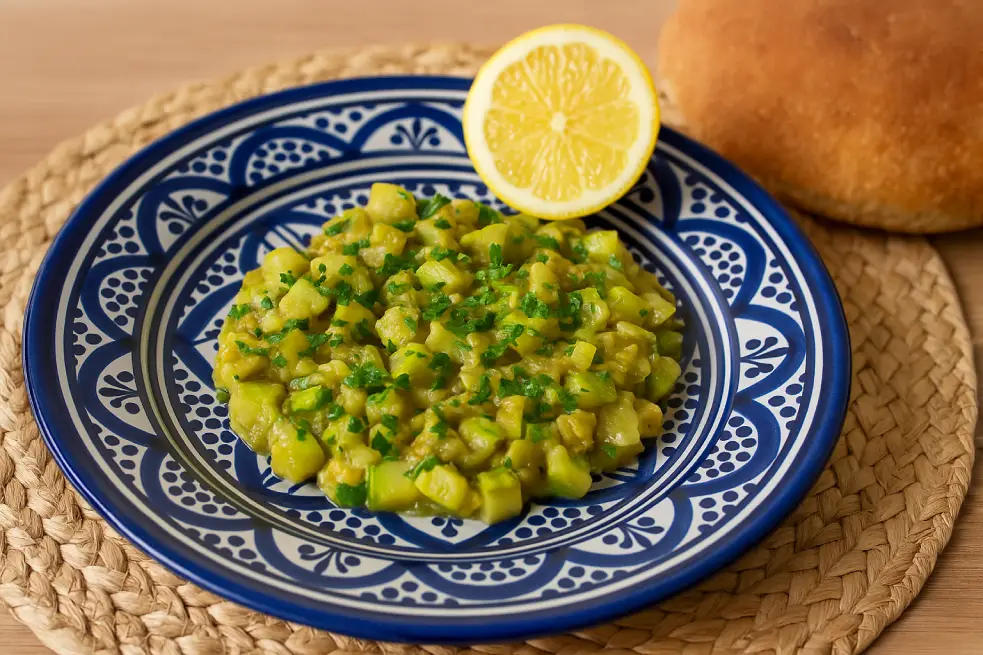
🏺A Classic Moroccan Side Dish from North Africa
In Moroccan culture, the table is rarely complete without an array of small side dishes known as kémia. The Moroccan zucchini salad, often served warm, is one of these staple Moroccan side dishes, typically appearing at family lunches, festive meals, and Ramadan iftars.
The preparation method uses everyday ingredients like fresh zucchini and aromatic herbs, staying true to the traditional values of Moroccan cuisine, simplicity, balance, and full flavor. Zucchini, known locally as courgette, is steamed or sautéed with olive oil, garlic, parsley, cilantro, cumin, and paprika. The result is a silky, spiced cooked vegetable salad that offers nourishment and comfort.
Its inclusion in daily meals highlights Morocco’s commitment to vegetable-forward dishes, a signature of North African cuisine. The zucchini salad is often served alongside other classics like harira, a hearty soup rich in legumes and tomatoes.
🥗 Differences Between Raw and Cooked Zucchini Salads
In many Western cuisines, zucchini salads are typically raw, sliced thinly or spiralized, and served with varous vinaigrettes. These are refreshing but fundamentally different from Moroccan-style preparations.
Here’s how they compare:
- Texture: Raw zucchini salads have a firm and crunchy texture, while Moroccan-style preparations result in a much softer, velvety finish.
- Flavor profile: Moroccan versions are infused with warm spices like cumin and paprika, providing a deeper, earthy profile.
- Serving style: Moroccan zucchini salad is typically served warm or at room temperature, which deepens its comforting and homestyle appeal.
This difference puts Moroccan zucchini salad in the category of gently cooked Mediterranean side dishes, appreciated for their depth and softness rather than crunch. It also showcases how Moroccan cuisine turns simple vegetables into richly flavored accompaniments through cooking and seasoning.
🍽️ Where It Fits in Moroccan Cuisine
The Moroccan zucchini salad is typically part of the salades marocaines, a selection of small salads served before the main course. These dishes are not mere appetizers; they represent Morocco’s culinary identity, which values balance, variety, and seasonal ingredients.
This salad fits exceptionally well into healthy Moroccan meal plans. It often accompanies tagines, roasted meats, or couscous dishes. Pairing it with this authentic couscous recipe creates a balanced, satisfying meal rich in fiber and nutrients.
Its role is practical and symbolic: it’s light, quick to prepare, and encourages vegetable consumption, making it ideal for anyone seeking fit food or low-calorie side dishes without sacrificing taste.
🌍 How It Compares to Other Mediterranean Salads
The Mediterranean region is known for its rich variety of vegetable-based salads. From Greek horta to Turkish ezme, each culture offers its take on what a salad can be.
What makes Moroccan zucchini salad stand out?
- Warm spices like cumin and paprika are used, but are not commonly found in other Mediterranean salads.
- Cooking method: Most Mediterranean salads are raw or grilled; Moroccan zucchini is gently cooked.
- Herb combination: The blend of parsley and cilantro is uniquely Moroccan.
This cooked salad aligns with the Mediterranean diet and is a perfect healthy fast option for modern dietary goals.
For further insights into the Mediterranean diet’s benefits and global recognition, consult the Harvard T.T.H. Chan School of Public Health, which highlights its impact on long-term health and weight control.
From the streets of Marrakech to your kitchen, the Moroccan zucchini salad reflects the soul of a cuisine built on simplicity, health, and flavor. As we’ll see in the following sections, its ingredients and preparation are as meaningful as its cultural roots.
🥬 Key Ingredients (Zucchini, Olive Oil, Garlic, Spices)
The foundation of this dish rests on a handful of essential ingredients that each contribute to its unique flavor and nutritional profile:
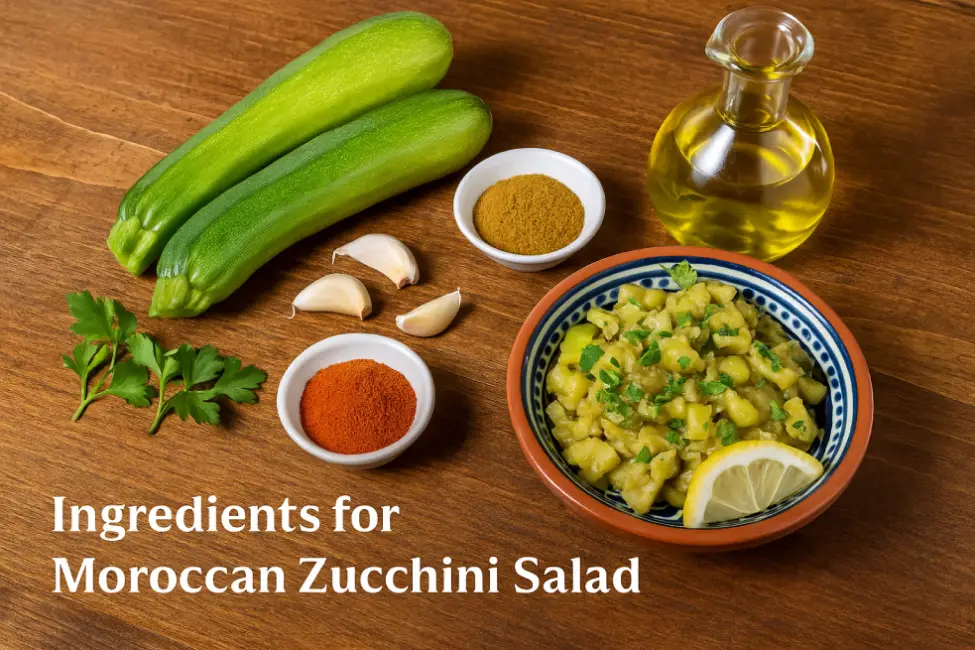
- Zucchini: A hydrating, low-calorie vegetable that softens beautifully when cooked.
- Olive oil: Known for its heart-healthy fats, it adds richness and depth while supporting anti-inflammatory benefits.
- Garlic: Adds pungency and aromatic complexity.
- Spices: Primarily cumin and paprika, which offer warmth and subtle smokiness.
- Herbs: Fresh parsley and cilantro are traditionally added for brightness.
These ingredients are pantry staples in many Moroccan homes. Their simplicity allows the spices and vegetables to shine without being masked by heavy sauces or dairy.
Moroccan cuisine’s flavor is sourced from ingredients through careful cooking and is not over complicated. The Moroccan zucchini salad is an ideal example of fit food, clean, natural, and satisfying.
🩺 Health Benefits of Zucchini and Olive Oil
Zucchini and olive oil aren’t just flavorful, they’re nutritional powerhouses:
- Zucchini is rich in water and fiber while low in calories, making it a go-to ingredient for those pursuing low-calorie meals or managing weight. It also contributes valuable micronutrients, including vitamin A for eye health and vitamin C for immune support.
- Olive oil, especially extra virgin, is a foundational ingredient in the Mediterranean diet. It’s rich in monounsaturated fats and antioxidants that help support heart health, reduce inflammation, and maintain healthy cholesterol levels.
Together, these two ingredients help make this salad an excellent addition to a healthy fast option or a fit meal.
🌱 A Naturally Vegan and Gluten-Free Recipe
A defining trait of Moroccan zucchini salad is that it comes together entirely from plant-based and gluten-free ingredients. There’s no need for substitutions or special versions. This makes it perfect for a wide range of dietary lifestyles:
- Vegan food enthusiasts are looking for plant-based meals.
- Gluten-sensitive individuals or those on gluten-free diets.
- Clean eaters who prefer whole, unprocessed ingredients.
Its pure ingredient list aligns seamlessly with modern wellness diets without losing cultural authenticity.
For a deeper dive into plant-based Moroccan cuisine, don’t miss this vibrant vegetable tagine recipe—another iconic dish that’s both vegan and intensely flavorful.
🧘♀️ Why This Salad Is Perfect for the Mediterranean Diet
The Mediterranean diet is globally recognized for its health benefits and sustainable approach to eating. It emphasizes vegetables, healthy fats, herbs, and whole foods, exactly what this salad offers:
- Uses zucchini and olive oil as staples.
- Incorporates spices and fresh herbs instead of processed flavorings.
- Contains no animal products or gluten.
Moroccan zucchini salad is an excellent choice for anyone following the Mediterranean lifestyle. It’s light, flavorful, and nutrient-dense.
If you want to learn more about how the Mediterranean diet can support long-term health and help reduce chronic disease risk, the Mayo Clinic offers a clear, research-backed overview.
With its balanced nutritional profile and adaptability to modern diets, Moroccan zucchini salad is more than just a flavorful dish, it’s a wise choice for mindful eaters. Whether vegan, gluten-free, or just hungry for something light and wholesome, this dish is central to any fit food routine.
👩🍳 How to Make Moroccan Zucchini Salad
🎥 To learn how Moroccan zucchini salad is traditionally prepared, from chopping the vegetables to serving the finished dish, you can watch this step-by-step video on YouTube:
👉 Watch the video tutorial on YouTubePlease note: This video is the property of its original creator. It is shared here for informational purposes only, with full credit to the content owner.
🔪 Prepping the Zucchini, Steamed or Sautéed?
Preparing zucchini correctly is key to achieving the signature texture of warm zucchini salad. You’ll need to choose between two traditional Moroccan cooking methods:
- Steaming: This method helps preserve the zucchini’s structure while making it tender. It’s beneficial when you want to reduce oil or keep it ultra-light.
- Sautéing: Many cooks prefer gently sautéing the zucchini in olive oil for a richer texture and deeper flavor. This allows the vegetable to absorb the surrounding spices more thoroughly.
In both cases, the zucchini is usually sliced into rounds or half-moons and cooked until it becomes soft but not mushy. The goal is a melt-in-the-mouth texture that carries the warm flavor of a Moroccan spiced vegetable dish.
If you’re new to cooking Moroccan food, zucchini is a forgiving ingredient that welcomes experimentation. It pairs beautifully with garlic, herbs, and olive oil.
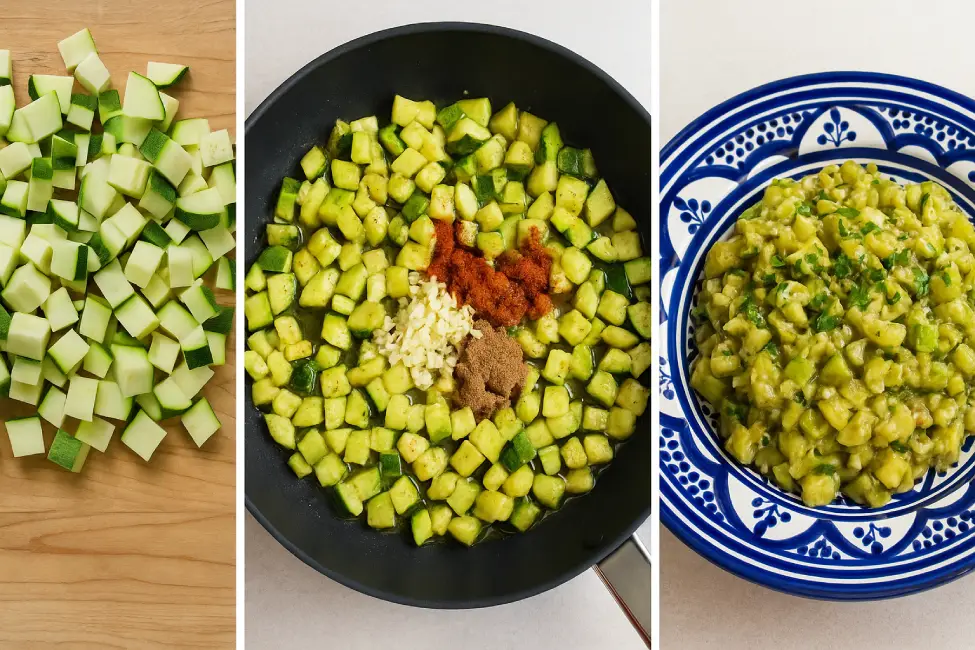
🧄 Flavoring with Garlic, Herbs, and Olive Oil
The soul of this salad lies in its aromatic base. Once the zucchini is cooked, it’s infused with a fragrant blend of garlic and olive oil, gently sautéed to avoid bitterness.
Add finely chopped:
- Garlic: Use 2–3 cloves, minced.
- Fresh herbs: Parsley and cilantro are traditional, so use both for balance.
Drizzle with high-quality olive oil while the zucchini is still warm, so it absorbs the flavor fully. This combination creates a vibrant, comforting taste without heavy sauces.
This base is often used in Moroccan households for other salads. It’s a flexible, health-conscious choice that aligns with Mediterranean diet values.
To explore a more complex herbal base in Moroccan cuisine, check out our recipe for chicken and gravy with Moroccan flavors, where similar aromatics are used.
🌶️ Spicing It Up, Cumin, Paprika, and More
Moroccan cooking relies heavily on warm spices that bring depth to simple vegetables. For this zucchini salad, a classic mix includes:
- Ground cumin: Earthy and slightly nutty
- Sweet paprika: Adds gentle warmth and color
- Salt and pepper: To taste
- Optional: A pinch of cayenne for subtle heat
These spices are lightly sautéed with the garlic before being added to the zucchini. This enhances the flavor complexity, transforming the dish into a well-rounded spiced vegetable salad.
The magic lies in not overpowering the dish, each spoonful should balance softness, aroma, and a light smoky finish.
🥗 Serving Suggestions, Warm or Cold?
Traditionally, Moroccan zucchini salad is served warm or at room temperature, making it ideal for everyday meals and special occasions. Here are a few versatile serving ideas:
- ✅ Serve warm as a side dish to grilled meat or fish
- ✅ Add it cold to a mezze platter with hummus, olives, and bread
- ✅ Use as a topping in a grain bowl or with couscous
It also pairs beautifully with traditional dishes like this stuffed sardines recipe for a well-rounded Moroccan spread.
Whether served warm for comfort or cold for freshness, this salad adapts easily to the seasons and your meal plan. It’s a shining example of how fit meals can be flavorful and deeply satisfying.
From prep to plating, Moroccan zucchini salad proves that simplicity and flavor can go hand in hand. The following section will explore why it’s more than a side dish, it’s a smart, flexible fit for any modern table.
🥗 Why It’s the Perfect Low-Calorie Fit Food
🧊 Low-Calorie, High-Flavor – No Compromise
Many “fit foods” are healthy but bland, not this one. The Moroccan zucchini salad is low in calories and flavorful, thanks to its innovative use of olive oil, garlic, cumin, and paprika. With each serving clocking in at fewer than 120 calories, it’s an ideal option for anyone seeking low-calorie meals that don’t taste like diet food.
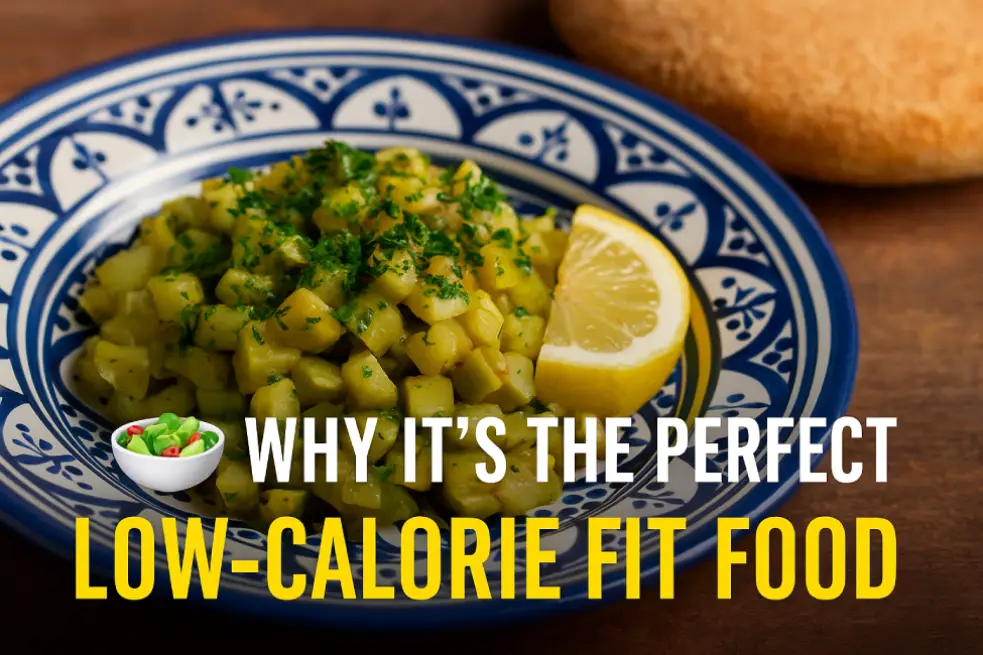
The magic lies in the balance between ingredients: instead of creamy dressings or sugary glazes, the flavor comes from fresh herbs, gently toasted spices, and natural vegetable sweetness. You’ll never feel like you’re sacrificing satisfaction for nutrition.
🍱 Great for Meal Prep and Quick Fit Meals
One of the unsung virtues of Moroccan zucchini salad is how well it fits into a meal prep routine. Make a batch on Sunday, store it in the fridge, and enjoy it:
- 🥗 On its own as a light lunch,
- 🥙 Stuffed in pita with chickpeas,
- 🍚 Over brown rice or quinoa bowls.
Because it’s a healthy fast option, it saves time during busy weekdays while keeping you on track with your fitness meal goals.
And the flavor improves over time, making it one of those rare dishes that tastes even better the next day.
⚖️ Ideal for Weight Loss and Clean Eating
This salad is tailor-made for those focusing on clean eating or managing their weight. Why?
- No processed ingredients or added sugars.
- Rich in fiber from zucchini and herbs.
- Contains healthy fats that promote satiety.
Combined, these make it a well-rounded dish that supports weight management without the feeling of restriction. You can fill half your plate with it and still have room for a protein like grilled fish or legumes.
To explore a satisfying protein pairing, try this shrimp and calamari tagine, light, flavorful, and beautifully complementary.
🫒 Approved by the Mediterranean Diet
Few dishes check as many boxes for the Mediterranean diet as Moroccan zucchini salad:
- ✅ Emphasis on vegetables
- ✅ Use of heart-healthy olive oil
- ✅ Rich in herbs and spices instead of salt
- ✅ Plant-based, gluten-free, and nutrient-dense
It’s a dish that aligns with modern nutritional science and cultural tradition. The Cleveland Clinic confirms that Mediterranean-style meals can reduce chronic disease risk while promoting long-term health (source).
Whether counting calories, following the Mediterranean lifestyle, or simply seeking dishes that fuel your day, Moroccan zucchini salad delivers every time. It’s the definition of a smart, flavor-forward fit food.
🧩 Variations, Pairings & Final Tips
🥕 Add Chickpeas, Carrots, or Grilled Eggplant
While the classic version of Moroccan zucchini salad is delicious, there’s plenty of room for creativity and nutrition boosts. Try these popular additions:
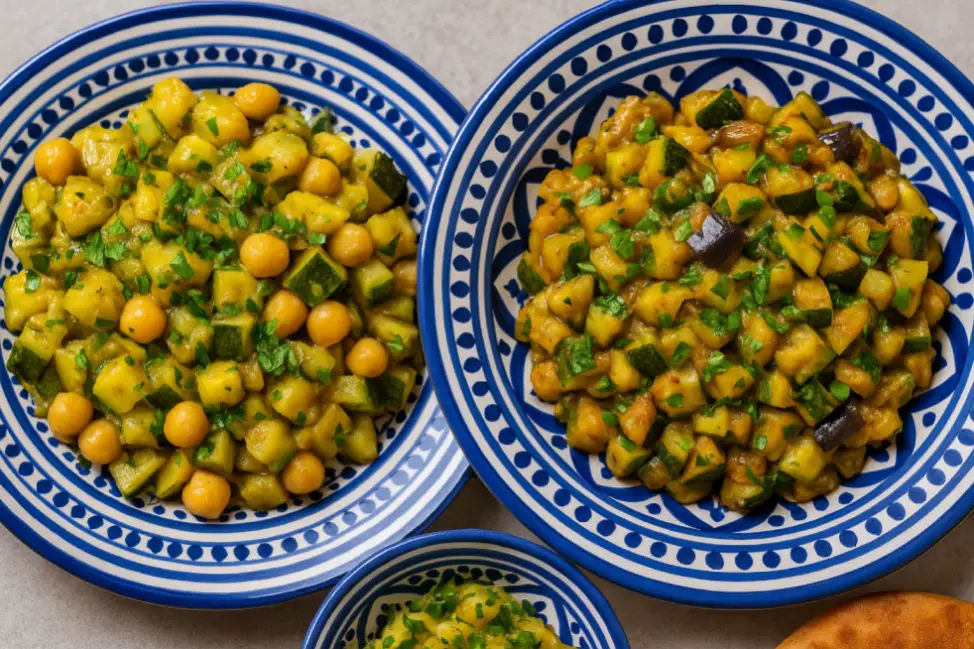
- Chickpeas: Add protein and a creamy bite, which is ideal for those looking for more filling vegetarian Moroccan dishes.
- Carrots: Thinly sliced or grated carrots add sweetness and color contrast.
- Grilled eggplant: A smoky, soft addition that complements the warm spices beautifully.
These extra ingredients turn your zucchini salad into a heartier dish without straying from its traditional Moroccan roots. You can modify the quantities of add-ins to match your preferences or suit different mealtime needs.
🍗 Pair It with Couscous, Fish, or Grilled Chicken
Wondering what to serve with couscous or a protein-packed entrée? This salad adapts effortlessly to many Moroccan and Mediterranean favorites:
- 🍽️ Serve alongside a plate of classic couscous for a light but satisfying lunch.
- 🐟 Try it with grilled or roasted fish such as ling cod for a bright and balanced dinner.
- 🍗 Pair it with grilled chicken or lamb for extra protein on training days.
Because it’s light yet flavorful, Moroccan zucchini salad works well with bold and straightforward mains.
❄️ Store and Reheat, Best Practices
This dish shines in meal prep settings thanks to its ability to store and reheat without losing quality. Follow these simple storage tips:
- For optimal freshness, refrigerate it in a sealed glass or BPA-free container and consume within 3 to 4 days.
- Warm it slowly on the stove using low heat or reheat it in the microwave in short bursts, frequently checking to maintain texture.
- For best results, stir in olive oil before reheating to refresh the texture.
It’s also delicious eaten cold, making it a reliable companion for quick meals during a busy week.
❓ Frequently Asked Questions (FAQ)
🥗 Is Moroccan zucchini salad a good make-ahead dish?
Absolutely. This dish is ideal for meal prep. It can be prepared several days ahead and kept fresh in the refrigerator, making it a practical choice for meal planning. Its flavor often improves with time.
🔥 Can I serve it cold?
Yes. Although it’s commonly served warm or at room temperature, this salad is equally enjoyable when chilled, perfect for a light and refreshing side dish or mezze during warmer months.
🧄 Can I replace garlic with something else?
If you’re sensitive to garlic, you can reduce the quantity or use roasted garlic for a milder taste. Shallots or green onions may offer a gentler alternative.
🥕 What other vegetables can I add?
Common additions include carrots, chickpeas, or grilled eggplant. These add bulk and nutrition while keeping the dish in line with Moroccan flavor profiles.
🧂 What spices are essential?
Cumin and paprika are the must-haves. A pinch of cayenne or ras el hanout can elevate the flavor, but they aren’t mandatory.
🧘♀️ Is this salad suitable for special diets?
Yes! This salad is entirely plant-based, gluten-free, and low in calories, making it suitable for various dietary needs. It’s also compliant with the Mediterranean diet and works well in weight loss meal plans.
🕒 How long does it take to make?
Preparation and cooking usually take about 20–25 minutes, making it an excellent option for quick lunches or weeknight dinners.
🌞 Final Thoughts & Try It Your Way
Moroccan zucchini salad welcomes interpretation, there’s flexibility in how it can be prepared and served. The ideal version is the one that aligns with your personal eating habits and flavor preferences. Whether you keep it traditional or enhance it with modern twists, the result will always be a dish that is:
- Easy to make
- Fit for all diets (vegan, gluten-free, low-calorie)
- Perfect for batch cooking
- Always packed with flavor
Need more ideas for Moroccan dishes that pair beautifully with this salad? For a bold flavor contrast, try serving it with this intensely flavorful lamb tagine with sweet onions—a comforting dish that pairs beautifully with the salad’s brightness.
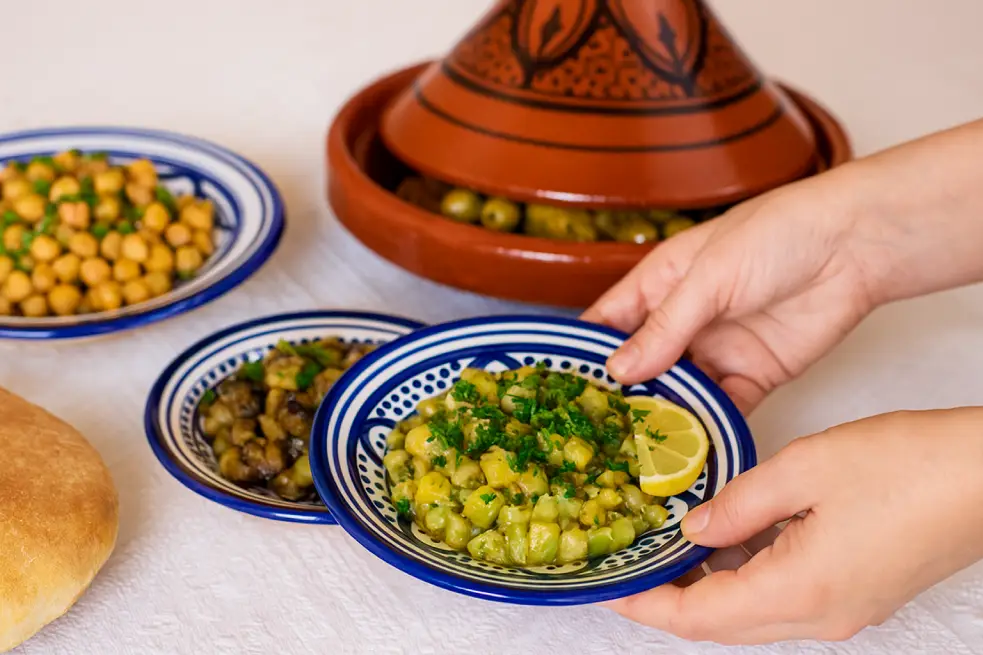
With its flexibility, simplicity, and bold flavor, Moroccan zucchini salad isn’t just a recipe—it’s a nourishing companion for anyone pursuing healthy, joyful eating.
Ready to bring Moroccan sunshine to your table?
🍽️ Try this zucchini salad today, and don’t forget to explore more authentic Moroccan recipes to complete your culinary journey. This dish will undoubtedly impress whether you cook for yourself, family, or guests!
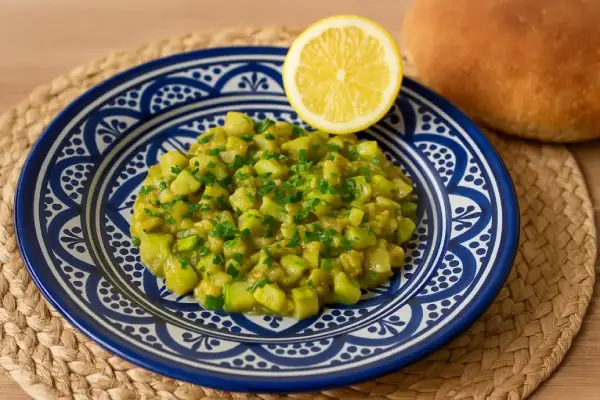
The Best Moroccan Zucchini Salad, A Low-Calorie Fit Food
Ingredients
🛒 Ingredients
- 3 medium zucchinis diced into small cubes
- 2 tablespoons olive oil extra virgin preferred
- 3 garlic cloves minced
- 1 teaspoon ground cumin
- 1 teaspoon sweet paprika
- Salt and black pepper to taste
- 2 tablespoons chopped fresh parsley
- 2 tablespoons chopped fresh cilantro
- Optional: 1 pinch cayenne pepper or ras el hanout for added heat
- Optional garnish: lemon wedge
Instructions
👨🍳 Instructions
- Wash and dice the zucchinis into small cubes.
- In a non-stick skillet or sauté pan, heat the olive oil over medium heat.
- Add the minced garlic and cook gently for 1–2 minutes until fragrant (do not brown).
- Add the diced zucchini and stir well to coat in the oil and garlic.
- Sprinkle in the cumin, paprika, salt, and pepper. Stir to combine.
- Cover and cook for 10–12 minutes, stirring occasionally, until the zucchini is tender but not mushy.
- Stir in the chopped parsley and cilantro.
- Optional: Add a squeeze of lemon juice before serving.
- Serve warm or at room temperature.
Notes
- This salad is even better the next day — perfect for meal prep.
- For added protein, stir in cooked chickpeas before serving.
- Can also be served cold as part of a mezze platter.
- Pair it with couscous, grilled fish, or lamb tagine for a full Moroccan meal.
🍽️ Nutrition Facts – Moroccan Zucchini Salad
(Per Serving – based on 4 servings)
| Nutrient | Amount |
|---|---|
| Calories | 110 kcal |
| Total Fat | 8 g |
| Saturated Fat | 1.2 g |
| Carbohydrates | 8 g |
| Fiber | 2.5 g |
| Sugars | 3.5 g |
| Protein | 2 g |
| Sodium | 190 mg |
| Potassium | 400 mg |
| Vitamin A | 12% DV |
| Vitamin C | 20% DV |
| Iron | 6% DV |
| Calcium | 3% DV |
Note:
Nutritional values are approximate and based on the standard version of the recipe (without added chickpeas or eggplant).
Adding legumes will slightly increase protein and carbohydrate content.
Olive oil is the primary source of healthy fats in this dish.
📲 Follow Me on Social Media!
Love discovering authentic Moroccan recipes like this zucchini salad?
Join me on social media for more delicious dishes, cooking tips, and healthy food inspiration from Morocco and beyond.
Let’s connect, tag me when you try a recipe, I’d love to see it! 💚
#MoroccanCuisine #HealthyEating #ZucchiniSalad #FitFood #MoroccanRecipes #CleanEating #TajineRecipes #FoodLovers #EatWellLiveWell
📨 Join the Moroccan Kitchen Newsletter!
Want more healthy, flavorful Moroccan recipes in your inbox?
Subscribe to my newsletter and get weekly recipe inspiration, cooking tips, and exclusive content straight from my kitchen to yours.
Whether you’re eating clean, exploring Moroccan flavors, or just love good food, this is for you! 🥘💌
📩 Join Our Moroccan Foodie Community
Get the best Moroccan tagine recipes and seasonal culinary tips straight to your inbox.
💬 Share Your Thoughts!
Have you tried this Moroccan zucchini salad?
I’d love to hear how it turned out for you!
Leave a comment below to share your experience, ask a question, or suggest your own twist — your feedback inspires others and helps grow our food-loving community. 🥗✨
